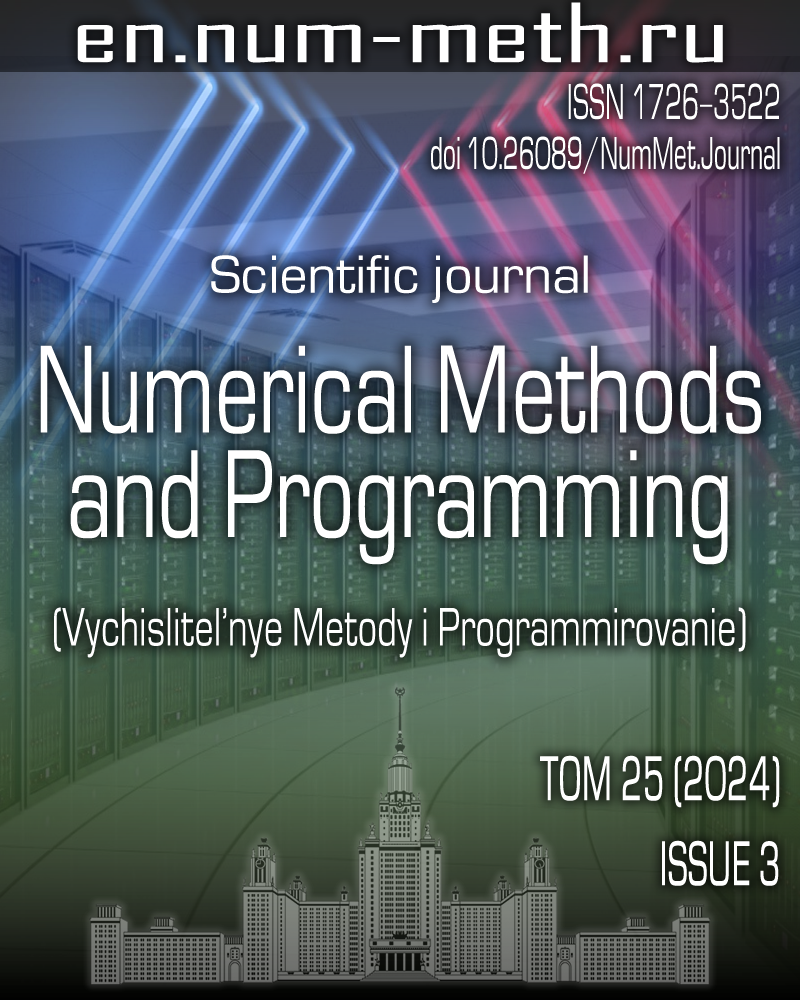DOI: https://doi.org/10.26089/NumMet.v25r327
Adaptive time-stepping for aggregation-shattering kinetics
Keywords:
Abstract
We propose an experimental study of adaptive time-stepping methods for efficient modeling of the aggregation-fragmentation kinetics. Precise modeling of this phenomena usually requires utilization of the large systems of nonlinear ordinary differential equations and intensive computations. We study the performance of three explicit Runge–Kutta time-integration methods and provide simulations for two types of problems: finding of equilibrium solutions and simulations for kinetics with periodic solutions. The first class of problems may be analyzed through the relaxation of the solution to the stationary state at large time. In this case, the adaptive time-stepping may help to reach this state using big steps reducing cost of the calculations without loss of accuracy. In the second case, the problem becomes numerically unstable at certain points of the phase space and may require tiny steps making the simulations very time-consuming. Adaptive criteria allows to increase the steps for most of the remaining point and speedup simulations significantly.
Published
Issue
Section
References
- P. L. Krapivsky, S. Redner, and E. Ben-Naim, A Kinetic View of Statistical Physics (Cambridge Univ. Press, Cambridge, 2010).
doi 10.1017/CBO9780511780516 - A. E. Aloyan, V. O. Arutyunyan, and A. N. Yermakov, “Dynamics of Gas Admixtures and Aerosols in Forest and Peat Fires,” Rus. J. Num. Anal. Math. Model. 29 (2), 79-92 (2014).
doi 10.1515/rnam-2014-0007 - M. V. Smoluchowski, “Versuch einer Mathematischen Theorie der Koagulationskinetik Kolloider Lösungen,” Zeit. Physikalische Chemie 92U (1), 129-168 (1918).
doi 10.1515/zpch-1918-9209 - A. A. Lushnikov, “Evolution of Coagulating Systems: III. Coagulating mixtures,” J. Colloid Interface Sci. 54 (1), 94-101 (1976).
doi 10.1016/0021-9797(76)90288-5 - F. Leyvraz, “Scaling Theory and Exactly Solved Models in the Kinetics of Irreversible Aggregation,” Phys. Rep. 383 (2-3), 95-212 (2003).
doi 10.1016/S0370-1573(03)00241-2 - K. Kang, S. Redner, P. Meakin, and F. Leyvraz, “Long-Time Crossover Phenomena in Coagulation Kinetics,” Phys. Rev. A 33 (2), 1171-1182 (1986).
doi 10.1103/PhysRevA.33.1171 - J. B. McLeod, “On an Infinite Set of Non-Linear Differential Equations,” Q. J. Math. 13 (1), 119-128 (1962).
doi 10.1093/qmath/13.1.119 - S. Kaushik and R. Kumar, “Steady-State Solution for Discrete Oort-Hulst-Safronov Coagulation Equation,” Int. J. Dyn. Syst. Differ. Equ. 13 (2), 144-163 (2023).
doi 10.1504/IJDSDE.2023.130311 - S. A. Matveev, A. P. Smirnov, and E. E. Tyrtyshnikov, “A Fast Numerical Method for the Cauchy Problem for the Smoluchowski Equation,” J. Comput. Phys. 282, 23-32 (2015).
doi 10.1016/j.jcp.2014.11.003 - S. A. Matveev, A. A. Sorokin, A. P. Smirnov, and E. E. Tyrtyshnikov, “Oscillating Stationary Distributions of Nanoclusters in an Open System,” Math. Comput. Model. Dyn. Syst. 26 (6), 562-575 (2020).
doi 10.1080/13873954.2020.1793786 - S. A. Matveev, P. L. Krapivsky, A. P. Smirnov, et al., “Oscillations in Aggregation-Shattering Processes,” Phys. Rev. Lett. 119 (26), Article Number 260601 (2017).
doi 10.1103/PhysRevLett.119.260601 - N. V. Brilliantov, P. L. Krapivsky, A. Bodrova, et al., “Size Distribution of Particles in Saturn’s Rings from Aggregation and Fragmentation,” Proc. National Academy of Sci. 112 (31), 9536-9541 (2015).
doi 10.1073/pnas.1503957112 - A. I. Osinsky, “Low-Rank Method for Fast Solution of Generalized Smoluchowski Equations,” J. Comput. Phys. 422, Article Number 109764 (2020).
doi 10.1016/j.jcp.2020.109764 - A. I. Osinsky and N. V. Brilliantov, “Exact Solutions of Temperature-Dependent Smoluchowski Equations,” J. Phys. A: Math. Theor. 55 (42), Article Number 425003 (2022).
doi 10.1088/1751-8121/ac971b - M. A. Larchenko, R. R. Zagidullin, V. V. Palyulin, and N. V. Brilliantov, “Application of Machine Learning Technique for a Fast Forecast of Aggregation Kinetics in Space-Inhomogeneous Systems,”
https://arxiv.org/pdf/2312.04660 . Cited September 10, 2024. - M. Smith and T. Matsoukas, “Constant-Number Monte Carlo Simulation of Population Balances,” Chem. Eng. Sci. 53 (9), 1777-1786 (1998).
doi 10.1016/S0009-2509(98)00045-1 - F. E. Kruis, A. Maisels, and H. Fissan, “Direct Simulation Monte Carlo Method for Particle Coagulation and Aggregation,” AIChE J. 46 (9), 1735-1742 (2000).
doi 10.1002/aic.690460905 - E. Debry, B. Sportisse, and B. Jourdain, “A Stochastic Approach for the Numerical Simulation of the General Dynamics Equation for Aerosols,” J. Comput. Phys. 184 (2), 649-669 (2003).
doi 10.1016/S0021-9991(02)00041-4 - K. K. Sabelfeld, S. V. Rogasinsky, A. A. Kolodko, and A. I. Levykin, “Stochastic Algorithms for Solving Smolouchovsky Coagulation Equation and Applications to Aerosol Growth Simulation,” Monte Carlo Methods Appl. 2 (1), 41-88 (1996).
doi 10.1515/mcma.1996.2.1.41 - M. H. Lee, “On the Validity of the Coagulation Equation and the Nature of Runaway Growth,” Icarus 143 (1), 74-86 (2000).
doi 10.1006/icar.1999.6239 - V. Stadnichuk, A. Bodrova, and N. Brilliantov, “Smoluchowski Aggregation-Fragmentation Equations: Fast Numerical Method to Find Steady-State Solutions,” Int. J. Mod. Phys. B 29 (29), Article Number 1550208 (2015).
doi 10.1142/S0217979215502082 - I. V. Timokhin, S. A. Matveev, N. Siddharth, et al., “Newton Method for Stationary and Quasi-Stationary Problems for Smoluchowski-Type Equations,” J. Comput. Phys. 382, 124-137 (2019).
doi 10.1016/j.jcp.2019.01.013 - R. C. Ball, C. Connaughton, P. P. Jones, et al., “Collective Oscillations in Irreversible Coagulation Driven by Monomer Inputs and Large-Cluster Outputs,” Phys. Rev. Lett. 109 (16), Article Number 168304 (2012).
doi 10.1103/PhysRevLett.109.168304 - N. S. Bakhvalov, G. M. Kobel’kov, and N. P. Zhidkov, Numerical Methods [in Russian]. (Fizmatlit, Moscow, 2000).
- T. A. Driscoll and R. J. Braun, Fundamentals of Numerical Computation (SIAM Press, Philadelphia, 2018).
doi 10.1137/1.9781611975086.fm - E. Fehlberg, “Classical Fourth and Lower Order Runge-Kutta Formulas with Stepsize Control and Their Application to Heat Transfer Problems,” Computing 6, 61-71 (1970).
doi 10.1007/BF02241732 - M. Saleh, E. Kovács, and N. Kallur, “Adaptive Step Size Controllers Based on Runge-Kutta and Linear-Neighbor Methods for Solving the Non-Stationary Heat Conduction Equation,” Netw. Heterog. Media 18 (3), 1059-1082 (2023).
doi 10.3934/nhm.2023046 - H. A. Zebker, E. A. Marouf, and G. L. Tyler, “Saturn’s Rings: Particle Size Distributions for Thin Layer Models,” Icarus 64 (3), 531-548 (1985).
doi 10.1016/0019-1035(85)90074-0 - T. V. Khodzher, V. A. Zagaynov, A. A. Lushnikov, et al., “Study of Aerosol Nano-and Submicron Particle Compositions in the Atmosphere of Lake Baikal during Natural Fire Events and Their Interaction with Water Surface,” Water, Air and Soil Pollut. 232 (7), Article Number 266 (2021).
doi 10.1007/s11270-021-05237-6
License
Copyright (c) 2024 Sergey A. Matveev, Viktor A. Zhilin, Alexander P. Smirnov

This work is licensed under a Creative Commons Attribution 4.0 International License.


